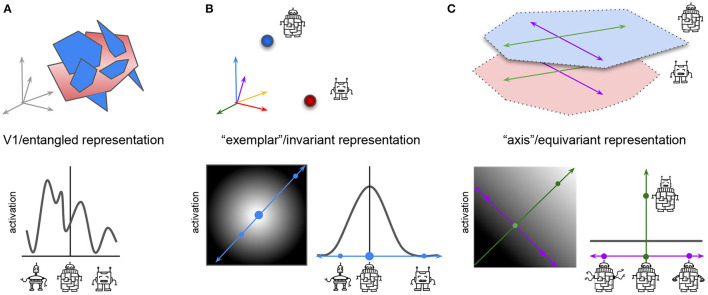Figure 2.
Different hypothesized coding properties of neurons at the start (A) and end (B,C) of visual processing in neural networks and the brain. Top row, schematic representation of manifolds representing two classes of robots: blue manifold contains robots that vary in the shape of their head, arms, legs, and body; red manifold contains robots that have no body and vary in the shape of their head, arms and legs only. Bottom row, schematic representation of the activations of a single idealized real or artificial neuron in response to variations in the visual stimulus. (A) (Top) Early processing stages have entangled high-dimensional manifolds. All information about the two robot categories, and their identity preserving transformations is present, but is hard to read out from the neural activations. Arrows represent the high-dimensional space spanned by all V1 neurons. (Bottom) Line plot shows the activation of a single idealized neuron in response to different robot variations. Neuron responds to robots from both classes. (B): “Exemplar” or invariant representation at the end of visual processing. Top: Single neurons have maximal firing for the prototype example of their preferred robot class (blue—with, red—without body). All information about the identity preserving transformations has been collapsed (illustrated by red or blue points), which makes object classification easy, but any other task (like clustering robots based on their arm variation) impossible. Arrows represent the high-dimensional space spanned by the higher-order neurons, arrow color represents preferred stimulus of the neuron. Bottom left: activation of a single idealized neuron to all robot variations from both classes. Lighter, higher activation. Big blue circle indicates preferred stimulus for neuron, resulting in highest activation, smaller blue circles indicate other robots resulting in lower to no activation. Blue arrow, cross section of robot variations shown in the line plot. Bottom right: line plot shows activation of the same idealized neuron as on the left but in the cross section of robot variations spanned by the blue arrow. Response declines proportionally to the distance from the preferred stimulus (big blue circle). (C) “Axis” or equivariant representation at the end of visual processing. Top: two robot classes have been separated into different representational manifolds, which are also aligned in terms of the shared transformations (e.g., both robot classes have similar identity preserving transformations in head shape, spanned by green axis; and arm shape, spanned by purple axis). This makes it easy to classify the robots, and solve other tasks, like clustering robots based on their arm variations. Bottom left: activation of a single idealized neuron to robot variations along the head shape change axis (green) and arm shape change axis (purple). Lighter, higher activation. Neuron has a ramped response proportional to changes in its preferred transformation (changes in head shape, green), and no change in firing to other transformations (e.g., changes in arm shape, blue). Bottom right: as in (B), but the cross section is spanned by the purple axis. Green dot indicates higher neural activation in response to a change in the robot head shape.

